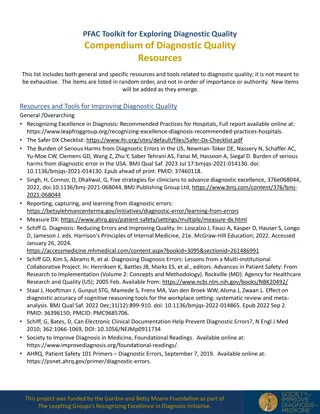Utilizing Different Samples for Diagnostic Testing in Medicine
The practice of diagnostic testing in medicine goes beyond blood and stool samples. Gathering urine samples, for example, allows healthcare providers to assess various health aspects, such as kidney function, urinary tract infections, diabetes, and more. By examining the color, clarity, odor, density, pH levels, and specific components like protein, glucose, nitrates, nitrites, white blood cells, and ketones in urine, medical professionals can gain valuable insights into a patient's overall health status and specific conditions. This article explores the significance of diverse sample types in diagnostic testing and how they help in monitoring and diagnosing various health issues.
Download Presentation

Please find below an Image/Link to download the presentation.
The content on the website is provided AS IS for your information and personal use only. It may not be sold, licensed, or shared on other websites without obtaining consent from the author.If you encounter any issues during the download, it is possible that the publisher has removed the file from their server.
You are allowed to download the files provided on this website for personal or commercial use, subject to the condition that they are used lawfully. All files are the property of their respective owners.
The content on the website is provided AS IS for your information and personal use only. It may not be sold, licensed, or shared on other websites without obtaining consent from the author.
E N D
Presentation Transcript
TY Science: Chemistry in diagnostic testing S. Kelleher
Besides a blood or stool (faeces) sample what other sample might a GP take from your body? Why? How is that diagnostically useful?
Urinalysis Diagnose urinary tract disease symptoms Show effectiveness of kidneys and other urinary tract organs Show drugs or chemicals in the blood Help you monitor the overall health of your body Confirm red urine (hematuria) is really blood Monitor presence or progression of Diabetes Kidney stones Kidney or liver diseases Urinary tract infection (UTI) High blood pressure (hypertension)
Urine Test Types Urine Colour - shows fluid balance, diet, medicines, and diseases. Level of darkness tests amount of water the urine. Vitamin B supplements can turn urine bright yellow. Some medicines, blackberries, beets, rhubarb, or blood in the urine can turn urine red-brown Urine Clarity - tests bacteria, blood, sperm, crystals, or mucus can make urine look cloudy Urine Odour - Diseases caused by bacteria can cause a bad odour, while diabetes can cause a sweet, fruity urine odour Urine Gravity or Density - tests substances in the urine and shows how well the kidneys balance water in urine Urine pH - tests acidity (alkaline) of urine. Urine pH of 4 is strongly acidic, 7 is neutral, and 9 is strongly alkaline
Urine Test Types Urine protein - tests protein presence in urine. Protein should not be present in urine, but hard exercise, pregnancy, and some diseases, especially kidney disease, may cause presence protein in urine. Presence of specific protein called Albumin is referred to as referred to as Albuminuria Urine glucose - tests glucose levels in blood. When blood sugar level is very high, it can be a sign of diabetes, or damaged kidneys Urine Nitrates and Nitrites - tests for urinary tract infection (UTI) to see level of enzyme that changes urinary nitrates to nitrites, which indicate UTI Leukocyte esterase (WBC esterase) - test white blood cells in the urine, indicating UTI. Urine Ketones - large amounts of ketones in the urine may mean diabetic ketoacidosis
Urine Test Types Microscopic urine analysis - tests urine sediment for red or white blood cells (not usually found in urine), inflammation, disease, or injury to the kidneys, ureters, bladder, or urethra. Urine casts - some urine tests show casts that form in tiny tubes in the kidneys, showing kidney disease may be present Urine crystals - urine test showing many crystals may indicate kidney stones or metabolism problems Bacteria, yeast cells, or parasites in urine indicate infection Squamous cells in urine - typically a sign that something went wrong with the test and it has to be re-done
Other substances that may be found in a urine test: Bilirubin - a substance formed by the breakdown of red blood cells, not typically found in urine. If Bilirubin is present, it may mean liver damage or that flow of bile from the gallbladder is blocked Urobilinogen - a substance formed by the breakdown of bilirubin. Large amounts of Urobilinogen can be a sign of liver disease (cirrhosis, hepatitis) Bence Jones protein - abnormal protein found in the urine tests in about 50% of people with a rare type of cancer called multiple myeloma
Before a urine test Do not eat foods or medicines that can colour the urine Do not exercise strenuously before the test, as that may effect urine colour (dehydration) and cause misleading urine test results.
Other urine tests include: Dipstick urine tests (colour change sticks) Pregnancy urine test Alcohol urine test Cocaine urine test Marijuana urine test STD urine test Performance enhancing drugs (metabolites)
Chemical test for protein: COLOUR CHANGE: blue to purple
Chemical test for sugar: COLOUR CHANGE: blue to brick red
Equipment for this experiment: Form into 5 groups 6 test tubes (unheated samples) 6 test tubes (heated samples) Clinistix Instead of Benedict s solution Temperature sensitive do not hold too long pH strips waterbath 370C
Test samples A F On the basis of your test results make a diagnosis Possible diagnoses: normal, drank alcohol excessively the night before the samples were taken, severe kidney damage, urinary tract infection (UTI), diabetes, involved in a car accident causing major damage to the brain and kidneys. When you chose match a diagnosis with a sample you must give a reason(s).
Questions you must answer in your laboratory write up Question 1: How could urine testing help in the smooth running of the Olympic Games or other major sporting events? Question 2: If a sample is not cloudy before heating, why does it become cloudy after heating?
Questions you must answer in your laboratory write up Question 3: Why are the methods you are using suitable for an initial diagnosis or GP inquiry but do not give a definitive diagnosis? Question 4: If you were a GP and you found that an initial test of urine from a patient indicated a serious condition would you inform them of your suspicions immediately or waiting for follow-up laboratory testing? Why?























